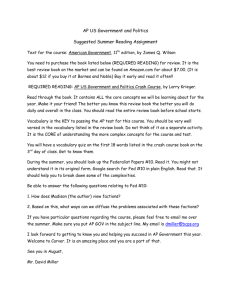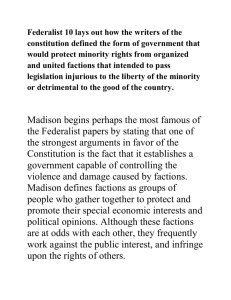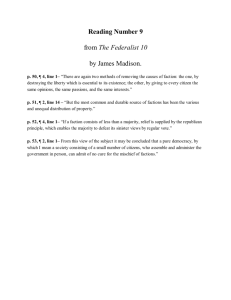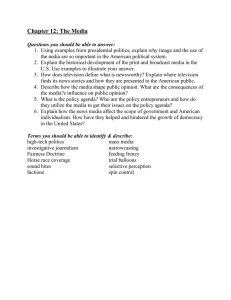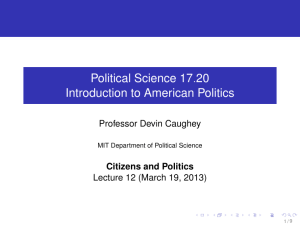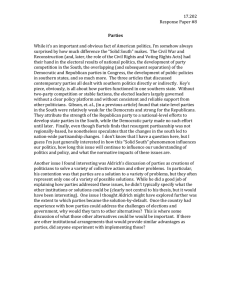Making Public Policy Lecture 19 eDMP: 14.43 / 15.031 / 21A.341/ 11.161 1
advertisement
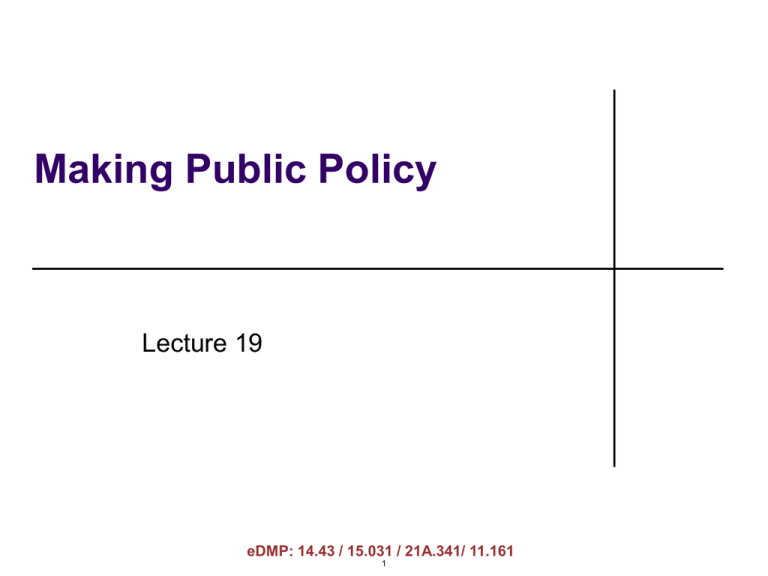
Making Public Policy Lecture 19 eDMP: 14.43 / 15.031 / 21A.341/ 11.161 1 Today’s Agenda • General discussion of making public policy – U.S. centric Constitutional Design: Madison in Federalist #10 Lowi on “interest group liberalism” Interest group competition, other processes • Clean Coal/Dirty Air/Trading Filth case – background, first two questions 2 Review: The market v. the “polis” • Governments rest on a (near) monopoly of force and, for stability, legitimacy (general acceptance) – Syria has former, not latter. • Individuals pursue self-interest v. individuals & groups pursue selfinterest & (different views of) the public interest; most decisions affect the whole community – collective choice, public goods… Preferences v. Ideologies: different views of how society should work & ideal arrangements to make it do so – reflects both values and beliefs • Competition v. competition & influence, cooperation, and loyalty • Goals: wealth v. wealth & power (the ability to get others to act against their self-interest, for your interest or your view of the public interest) – rests on influence, cooperation, loyalty, and, sometimes, force • Without a dictator, no guarantee of collective consistency, so no way to guarantee decisions/policies optimal in any sense… E.g., Condorcet (1785) paradox of voting: 3 voters, 3 alternatives, preferences A>B>C, C>A>B, B>C>A; voting A>B, B>C, C>A… 3 So, How to Design a Government? • Not an optimization problem with one objective… • Faced by U.S. “Founding Fathers” – no contemporary models; Roman republic, Athens fell During the Revolution adopted the Articles of Confederation (1777): no executive branch, central government couldn’t tax Constitution drafted in 1787, but serious, organized opposition in several states including New York; ratification not a slam dunk Hamilton, Madison, and Jay wrote the Federalist Papers under pseudonyms to argue for ratification, esp. in New York • What design problem is the focus of Federalist #10? Faction: “a number of citizens … who are united and actuated by some common impulse of passion, or of interest, adverse to the rights of other citizens or to the permanent and aggregate interests of the community” 4 Let’s Walk Through Madison’s Solution • Could one eliminate the basic causes of factions? Only if eliminate liberty or differences (property); unwise & impractical • How can one deal with minority factions? Voting should handle this… • Can one eliminate majority factions in a pure democracy? • Why does he think a large republic is a good answer to the problem of majority factions? Larger districts better candidates available, more likely to win…? Diversity & Dispersion: “Extend the sphere, and you take in a greater variety of parties and interests; you make it less probable that a majority of the whole will have a common motive to invade the rights of other citizens; or if such a common motive exists, it will be more difficult for all who feel it to discover their own strength and act in unison with each other.” 5 Politics as competition among interest groups • Madison: factions are inevitable, but if they are all small & weak, none can dominate competition among them • Lowi: such competition among interest groups has become both an accepted description of US politics and, implicitly, an ideal – “interest group liberalism” – K Street • Lowi: For this to make sense as any sort of (non-rigorous) Adam Smith ideal, need (at least) “Organized interests are homogeneous and easy to define” “Organized interests pretty much fill up and adequately represent most of the sectors of our lives… “ (spanning, always competition ) “the role of government is one of ensuring access, particularly to the most effectively organized, and of ratifying the agreements and adjustments worked out among the competing leaders and their claims” (ideology!) • Are these sensible as descriptions? As an Ideal? 6 Observations on interest group competition • Empirically, ability to organize is key; helped by Small number of potential members: airlines v. travelers Higher $$ stage for each potential member Shorthand: concentrated interests beat diffused interests • One important mode of competition is $$ in elections Less to buy votes than to elect friends, ensure access Many groups contribute to sure winners, both R’s and D’s Citizens United decision has removed spending limits; inequality in wealth, income has risen sharply (causes??) • Another mode is lobbying "(Klein, Ezra. "Our Corrupt Politics: It's Not All Money," The New York Review of Books, March 22, 2012.)" NOT mainly about bags of money; a “gift economy” Effective lobbyists provide friends with information Lobbying firms recruit people with powerful friends... 7 But not all politics is inside baseball (Lowi) Types of Coercion, Types Of Policy, and Types Of Politics Applicability of Coercion Through: Individual Conduct Likelihood of Coercion: Remote Environment of Conduct Distributive policy (e.g., 119th Century land policies, tariffs, subsidies Constituent policy (e.g., reapportionment, setting up a new agency, propaganda) Regulative policy (e.g., Elimination of substandard goods, unfair competition, fraudulent advertising) Redistributive policy (e.g., Federal reserve controls of credit, progressive income tax, social security) "Party (Electoral Organization) Logrolling" -vs- Immediate Decentralized Disaggregated Local -vsInterest Identity (Person) "Group (Interest Organization) Bargaining" Centralized "Systems" Level Cosmopolitan Ideology Status (Type of Person) Image by MIT OpenCourseWare. 8 And there are alternative models, which may be more useful in some settings (Whitt, a Marxist) Variable Pluralistic Elite Class-Dialectic Basic units of analysis Interest groups Institutional elites Social institutions; social classes Essential processes Interest group competition Hierarchical dominance by elites Imperatives of social institutions; class domination and conflict Basis of group power (resources) Many bases; organizational, governmental, social, personal Institutional position, common social background, convergent interests Class position; degree of class consciousness and organization Distribution of power Dispersed among competing, heterogeneous groups Concentrated in relatively homogenous elites Held by dominant class, but potentially available to subordinate classes Limits and stability of groups’ power Unstable; limited by democratic value consensus, shifting strength among organized interests and by cross-cutting allegiances Stable, no identifiable limits to elite domination Historically contingent; generally stable, but limited by class conflict and contradictions within and among social institutions Conception of role of the state State is a broker, able to preserve some autonomy by balancing competing interests State has little, if any, autonomy, captive of elite interests Image by MIT OpenCourseWare. Source: Whitt, J. A., Urban Elites and Mass Transportation. Princeton: Princeton University Press, 1982. 9 Federal Regulation: Background • Laws typically give US state/federal agencies architecture, discretion, vague mandates like “just & reasonable,” “protect human health” • Broadly, agencies are either “independent” (e.g., FERC, PUCs) or part of the executive branch (e.g., EPA) Independent agencies an invention of the Progressive era (1910s); to have expertise, be “immune” to politics Really only partly immune (appointment), may be captured by regulated interests; exec branch agencies to be “responsible” Status affects extent, kind of executive oversight; federal executive branch agencies’ rules reviewed by OIRA in OMB • All Federal agencies’ decisions reviewable by the courts under the APA of 1946; similar laws in most states Courts reject if “arbitrary and capricious, an abuse of discretion, or otherwise not in accordance with the law” Usually must seek and take into account “public comment” – usually from organized interest groups 10 EPA Regulation of SO2 from power plants • Was the 1970 Clean Air Act (signed by Nixon!) the result of interest group competition? • In 1971 and later years, what interest groups affected the decisions described in the case? Eastern and Western coal producers Electric utilities Western states Environmental groups • What interests (if any) were not represented in this process? • What basic architecture did the 1970 Act set up as regards coalfired power plants? What roles were assigned to the states? To EPA? • What was the basic rationale for the different treatment of new and existing power plants? 11 Next two sessions: • Social movements – which got the 1970 Act, civil rights legislation, and much else passed • U.S. environmental regulation – which is a major component of U.S. energy policy EPA regulation in general Back to the case: the politics of the 1971 NSPS, the 1977 Amendments, and the 1979 NSPS The acid rain impasse and the emergence of emissions trading, later developments 12 MIT OpenCourseWare http://ocw.mit.edu 15.031J / 14.43J / 21A.341J / 11.161J Energy Decisions, Markets, and Policies Spring 2012 For information about citing these materials or our Terms of Use, visit: http://ocw.mit.edu/terms.
